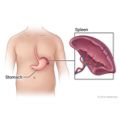Health Library
We have a vast digital library of medical information, including wellness and psychiatry topics as well as general medical topics. For more information or to schedule an appointment, don’t hesitate to call us.
Our Health Library information does not replace the advice of a doctor. Please be advised that this information is made available to assist our patients to learn more about their health. Our providers may not see and/or treat all topics found herein. Laparoscopy (say "lap-uh-ROSS-kuh-pee") is a type of surgery that uses very small cuts in the belly. These cuts are called incisions. The doctor puts a lighted tube (scope) through an incision in your belly. Then the doctor puts special tools through the other incisions to do the surgery. With laparoscopy, the doctor can find out what's causing symptoms, repair or remove an organ, take tissue samples for biopsy, and more. For some surgeries, you can usually go home the same day. The incisions from the surgery usually leave small scars that fade over time. Laparoscopy is done to: Surgery can be stressful. This information will help you understand what you can expect. And it will help you safely prepare for surgery. Laparoscopy is done by a surgeon. General anesthesia is most often used. But other types of anesthesia, such as spinal anesthesia, may be used. Ask your surgeon which choice is best for you. About an hour before the surgery, you'll empty your bladder. You'll get fluids and medicine through an intravenous (I.V.) line in a vein in your arm. You may get a medicine (sedative) to help you relax. A thin, lighted tube (laparoscope) is inserted into the belly through a small incision, usually made below the navel. The belly is inflated with air, which pushes the wall of the belly away from the organs so the surgeon can see them more clearly. Other incisions may be made so special tools can be used to take tissue samples, fix a problem, or drain cysts. A laser may be attached to the laparoscope to help with the surgery. After the surgery, the tools will be removed and the air will be released. The incisions will be closed with stitches and covered with a bandage. The scars are small and will fade over time. After the laparoscopy, you'll go to the recovery room. How long you stay will depend on why you had the surgery. Laparoscopy usually takes about 60 to 90 minutes, depending on what is done. But it can take longer if the surgery becomes more complicated. If general anesthesia is used, you will be asleep and feel nothing. After you wake up, you will feel sleepy for several hours. You may be tired and have some pain for a few days after a laparoscopy. You may have shoulder pain. This is caused by the air your doctor put in your belly to help see your organs better. The pain may last for a day or two. If you have other types of anesthesia, you may have pain for a few days when the initial numbness wears off. There is a small chance of problems from laparoscopy, such as: A laparoscopy may not be done because of a higher chance for problems if you have: Results of any lab tests on tissue samples may not be available for several days. Current as of: October 1, 2025 Author: Ignite Healthwise, LLC Staff Current as of: October 1, 2025 Author: Ignite Healthwise, LLC Staff Clinical Review Board This information does not replace the advice of a doctor. Ignite Healthwise, LLC disclaims any warranty or liability for your use of this information. Your use of this information means that you agree to the Terms of Use and Privacy Policy. Learn how we develop our content. To learn more about Ignite Healthwise, LLC, visit webmdignite.com. © 2024-2025 Ignite Healthwise, LLC.Laparoscopy
Why It Is Done
How To Prepare
Preparing for surgery
How It Is Done
How long the test takes
Watch
How It Feels
Risks
Results
Normal
Abnormal
Related Information
Credits
Clinical Review Board
All Ignite Healthwise, LLC education is reviewed by a team that includes physicians, nurses, advanced practitioners, registered dieticians, and other healthcare professionals.
All Ignite Healthwise, LLC education is reviewed by a team that includes physicians, nurses, advanced practitioners, registered dieticians, and other healthcare professionals.







